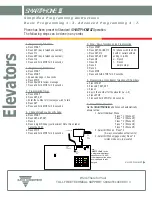
9-16
Cisco Unified IP Phone 7975G Administration Guide for Cisco Unified Communications Manager 7.0 (SCCP and SIP)
OL-15790-01
Chapter 9 Troubleshooting and Maintenance
Using the Quality Report Tool
After you press these keys, the line buttons on the phone flash orange and then green, and the phone goes
through the factory reset process. This process can take several minutes.
Do not power down the phone until it completes the factory reset process, and the main screen displays.
Using the Quality Report Tool
The Quality Report Tool (QRT) is a voice quality and general problem-reporting tool for the
Cisco Unified IP Phone. The QRT feature is installed as part of the Cisco Unified Communications
Manager installation.
You can configure users’ Cisco Unified IP Phones with QRT. When you do so, users can report problems
with phone calls by pressing the
QRT
softkey. This softkey is available only when the
Cisco Unified IP Phone is in the Connected, Connected Conference, Connected Transfer, and/or
OnHook states.
When a user presses the
QRT
softkey, a list of problem categories appears. The user selects the
appropriate problem category, and this feedback is logged in an XML file. Actual information logged
depends on the user selection, and whether the destination device is a Cisco Unified IP Phone.
For more information about using QRT, refer to
Cisco Unified Communications Manager Features and
Services Guide
.
Monitoring the Voice Quality of Calls
To measure the voice quality of calls that are sent and received within the network, Cisco Unified IP
Phones use these statistical metrics that are based on concealment events. The DSP plays concealment
frames to mask frame loss in the voice packet stream.
•
Concealment Ratio metrics—Show the ratio of concealment frames over total speech frames. An
interval conceal ratio is calculated every 3 seconds.
•
Concealed Second metrics—Show the number of seconds in which the DSP plays concealment
frames due to lost frames. A severely “concealed second” is a second in which the DSP plays more
than five percent concealment frames.
•
MOS-LQK metrics—Use a numeric score to estimate the relative voice listening quality. The Cisco
Unified IP Phone calculates the mean opinion score (MOS) for listening quality (LQK) based
audible concealment events due to frame loss in the preceding 8 seconds, and includes perceptual
weighting factors such as codec type and frame size.
MOS LQK scores are produced by a Cisco proprietary algorithm, Cisco Voice Transmission Quality
(CVTQ) index. Depending on the MOS LQK version number, these scores might be compliant with
the International Telecommunications Union (ITU) standard P.564. This standard defines evaluation
methods and performance accuracy targets that predict listening quality scores based on observation
of actual network impairment.
Note
Concealment ratio and concealment seconds are primary measurements based on frame loss while MOS
LQK scores project a “human-weighted” version of the same information on a scale from 5 (excellent)
to 1 (bad) for measuring listening quality.
















































